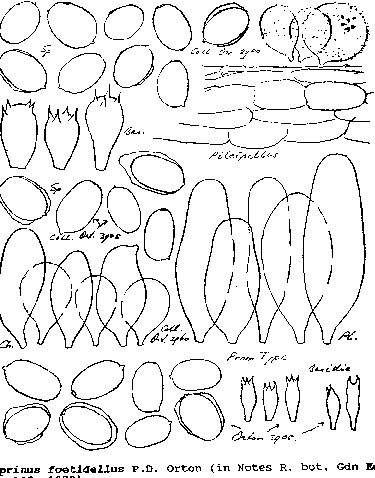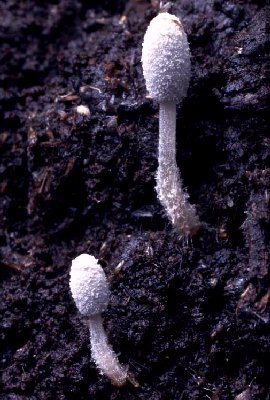Macroscopic features |
Pileus up to 6 x 4 mm when still closed, up to 7(-10) mm when expanded, subglobose to oblong, densely covered with mealy to hairy floccose veil, pale grey to mouse grey. Lamellae free, white to black. Stipe 15-40(-60) x 0.5-1 mm, whitish; base somewhat clavate. Smell strong, >narcotic=. |
Microscopic features |
Spores 7.6-10.8 x 4.6-7.0 µm, Q = 1.40-1.60, av. Q = 1.50-1.65, av. L = 9.0-9.8 µm, av. B = 5.5-6.1 µm, ellipsoid or ovoid, with rounded base and apex, dark red-brown; germ pore central, 1.2-1.4 µm wide; episporium sparse, smooth, up to 1 µm wide in places. Basidia 8-20 x 6-8 µm, 4-spored, surrounded by 3-5 pseudoparaphyses. Pleurocystidia 50-90 x 18-30 µm, utriform or oblong. Cheilocystidia 20-50 x 14-22 µm, (sub)globose, ellipsoid, oblong or utriform. Pileipellis made up hyphoid elements. Elements of veil up to 60(-70) µm wide, made up of globose, warty cells connected with narrow, diverticulate hyphae. Clamp-connections not found. |
Habitat & distribution |
Rare, on pure or mixed dung. Known from England and The Netherlands. |
Remarks |
The absence of sclerotia, the presence of strong, >narcotical= smell and the small basidiocarps are characters to recognize Coprinus foetidellus. Coprinus tuberosus usually grows from sclerotia, have no >narcotical= smell and larger basidiocarps. Coprinus trisporus have three-spored basidia. |

[Copyright © by Uljé]

[Copyright © by Bart Horvers]